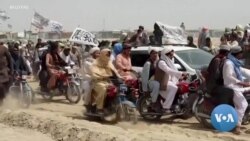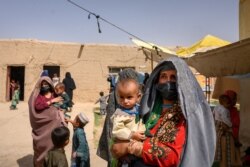The day the Taliban entered Balkh district, 20 km west of Mazar e Sharif, the capital of Balkh province last month, local radio station Nawbahar shuttered its doors and most of its journalists went into hiding.
Within days the station started broadcasting again, but the programming was different. Rather than the regular line-up, Nawbahar was playing Islamist anthems and shows produced by the Taliban.
The switch in programming is a far cry from how Nawbahar usually operates. The station started up in the northern province in 2004—broadcasting news and entertainment in Dari and Pashto languages thanks to funds from the U.S. Agency for International Development.
Its experience reflects a growing trend for Afghanistan’s independent media. As the security situation deteriorates, so does the situation for all the other gains the country made in the last 20 years, including press freedom.
The Reuters Institute for the Study of Journalism says Afghanistan went from zero independent media under Taliban rule to 170 radio stations, more than 100 newspapers, and multiple TV stations since the U.S.-led invasion of the country 20 years ago.
Now that foreign troops are almost gone and the Taliban have nearly doubled the territory under their control, many journalists working in insecure areas are fleeing to safety.
Nearly 50 journalists in territory newly under Taliban control have either been forced to leave or evacuated out of fear for their lives in recent weeks. More than 20 media outlets have stopped operating, while others are forced to broadcast Taliban propaganda, according to Najib Sharifi, president of Afghan Journalists Safety Committee that monitors threats against media.
“We have at least five media stations, private media outlets, that have been taken over by the Taliban, and through these five stations, Taliban broadcast their propaganda,” Sharifi told VOA. “They have also stopped broadcasting of music and voices of women.”
Sharifi said that in many areas the Taliban seems to be reverting to the same practices they used in the 90s when they ruled the country under a brutal Islamist code, under which women had no place in public life.
In a WhatsApp call to VOA, Taliban spokesman Suhail Shaheen denied the allegations.
“We only took over radio stations run by Kabul government since they were government owned, and we replaced that government. But private radio stations are allowed to operate, and we have told journalists to operate them normally.”
Shaheen said that women were allowed to broadcast as long as they wear a hijab, but “music is a different matter.”
Despite Taliban denials and reassurances, local journalists continue to flee as the militants approach. Four VOA reporters are among the dozens who have left for the relative safety of the capital, Kabul.
One of those is Lina Shirzad, a contributor who worked in Faizabad, the capital of Badakhshan province. As a female journalist working in a conservative province, her work was twice as hard. But Shirzad said she had started receiving anonymous death threats.
“They told me to stop working in media, but I continued. I never expected that Taliban would surround my hometown and I won’t be able to work as a journalist anymore,” she said.
Shirzad has left the area, but she worries about family who remained.
“When I make calls to find out about the situation, it seems like it’s getting worse,” she said.
Afghanistan was already one of the most dangerous countries for journalists. Last week, Pulitzer Prize winning Reuters photographer Danish Siddiqui was killed when the Afghan special forces he was embedded with came into direct contact with the Taliban.
Now, with the mass movement of journalists from some areas, the physical risks have compounded threats to the flow of free and impartial information at a time when accusations of human rights atrocities are rising from both sides.
“We are facing an extensive media blackout in areas that have been captured by the Taliban,” Sharifi said. “We don’t know what’s going on there because there are no journalists to report what’s happening with people, what’s happening with the Taliban, how they offer governance to the people, how they offer services to the people.”
As if physical threats and lack of access was not enough, journalists in Afghanistan are increasingly facing yet another hurdle—an avalanche of propaganda and fake news through social media.
“A significant amount of propaganda is being orchestrated and disseminated, mostly by the Taliban,” Sharifi said, adding that it was becoming very difficult for journalists to filter between fact and fiction.
Journalists in Afghanistan say they are not just worried about their careers but the future of journalism.
“If the current situation continues, then you might as well have a funeral for journalism or freedom of press in Badakhshan and other provinces in the north,” Shirzad said.







